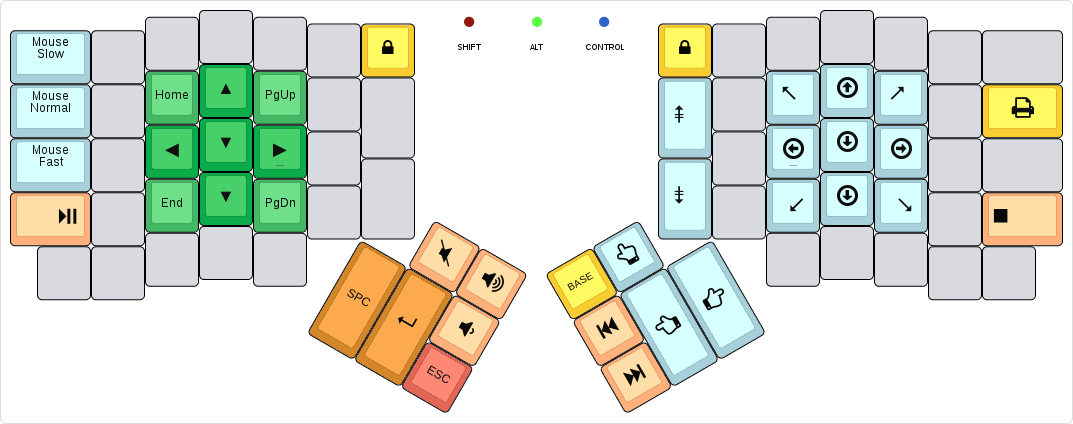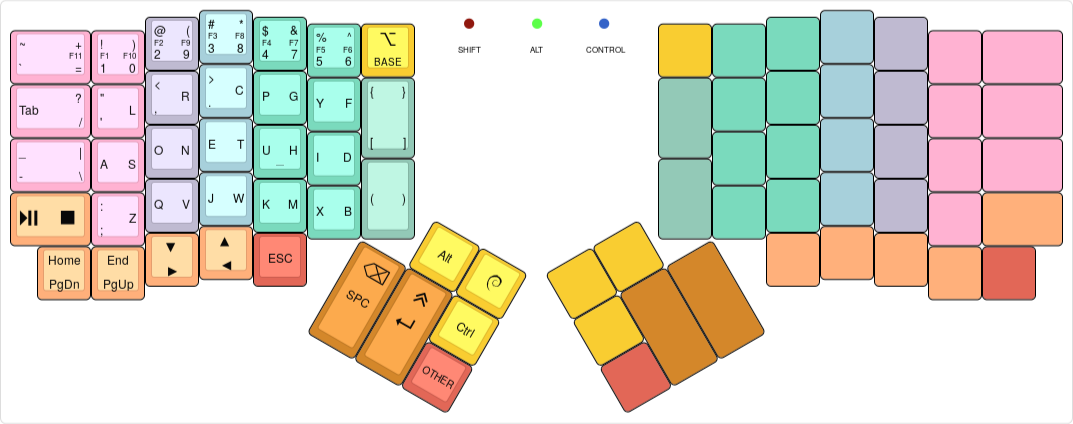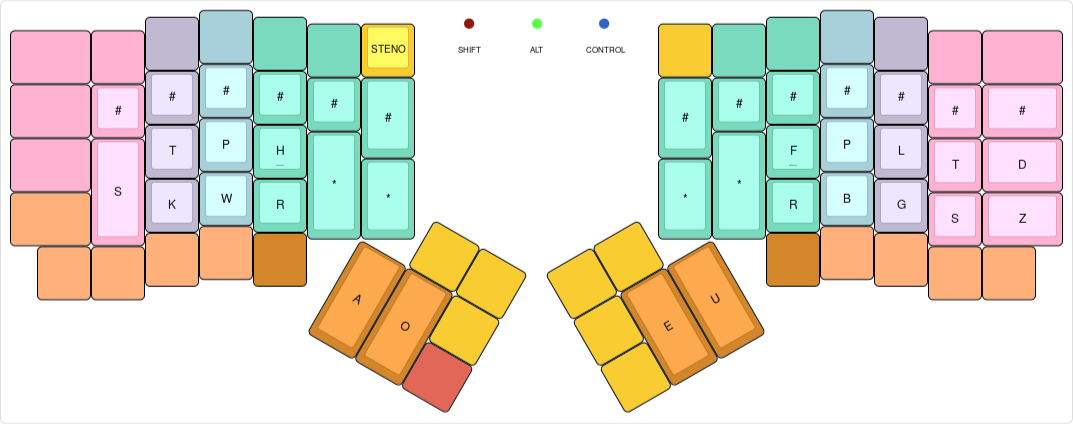* redoes matrix pins, abstracts backlight code for B5,6,7 * slimming down keyboard stuff, backlight breathing implemented * don't call backlight init when no pin * cleans up user/kb/quantum calls, keyboard files * fix pvc atomic * replaces CHANNEL with correct var in breathing * removes .hexs, updates readmes, updates template * cleans-up clueboards, readmes to lowercase * updates readme
algernon's layout
This is an unconventional layout for the ErgoDox EZ. For more details about the history of the layout, see my blog posts about my ErgoDox journey.
Some of the things in the layout only work when one uses Spacemacs and GNOME under Linux. Your mileage may vary.
Table of Contents
Layouts
Base layer
At its core, this is a Dvorak layout, with some minor changes. The more interesting parts are how certain keys behave:
- The keys on the number row double as function keys, when held for a bit longer than an usual tap. This allows me to use the function keys without having to switch layers.
- The
Shift,Alt, andControlmodifiers are one-shot. When tapped, they are considered active for the next key press only. When double tapped, they toggle on, until a third, single tap sometime later. When held, they act as expected. My usual pattern is that I use these for the next keypress only, so this behaviour is perfect. If I need them held, I'll just double-tap. - The
GUIkey is special, because when I double-tap it, it sendsGUI + w, which pops up an application selector. It also switches to a one-shot layer, where the number row on the left half turns into app selector macros, for the most common things I usually want to switch to. Otherwise it behaves as on a normal layout. - The
ESCkey also doubles as a one-shot cancel key: if tapped while any of the one-shot modifiers are in-flight (as in, single-tapped, and not expired yet), it cancels all one-shot modifiers. It also cancels the Hun layer, if active. Otherwise it sends the usual keycode. - The Media, Arrow, and Hun layer keys are one-shot, the 1Hand and STENO keys are toggles.
- Toggling the Arrow layer toggles between the cursor arrows and the paging keys on the bottom row.
- Tapping the
:key once yields:, tapping it twice yields;. - The Lead key allows me to type in a sequence of keys, and trigger some
actions:
LEAD uenters unicode input mode, by sending the GTK+ key sequence that does this.LEAD luses the unicode input method to enter aλ.LEAD sdoes a lot of magic to type in a shruggie:¯\_(ツ)_/¯LEAD ytypes\o/.LEAD w mmaximises the currently focused window.LEAD emakes the experimental layer the default.LEAD vprints the firmware version, the keyboard and the keymap.
Experimental layer
While using the standard Dvorak layout, I encountered a number of inconveniences, and on this layer, I am playing with ideas to make the layout feel better. Initially, it was based on Capewell-Dvorak, but that too, had shortcomings I was not happy with. So now this is something inbetween, with own observations thrown in. How it works out in the long run remains to be seen.
Hungarian layer
On this layer, the accented characters are at the same position as their base variant. For some, which can have other diatribes, the long one is on top, short's on bottom. Tapping any of the accented characters takes us back to the base layer.
Navigation and media layer
This layer is primarily for navigating with the cursor or the mouse, and some media things.
One-handed layer
The one-handed layer is used in situations where the right hand is occupied, by
mousing around, for example. Tapping the OTHER key switches which side is
active. For the most part, keys remain in their usual position. When the right
half is active, keys are mirrored to the left half.
The differences are as follows:
- The
ESCkey has been moved to the bottom row, so theOTHERkey is easier to tap. - Most keys on the thumb cluster now have dual uses, and these do not change
when switching sides:
- The
Space/Backspacekey sendsSpaceon tap,Backspacewhen held for longer than a normal tap. - The
Enter/Shiftkey sendsEnteron short-tap,Shifton long-tap.
- The
- The
Apps/BASEkey can be used to go back to the base layer, by long-tapping it. A short-tap will send theAppkey, as usual.
Steno layer
This is to be used with Plover, nothing really fancy here. The STENO key toggles the layer on and off, and sends the toggle command to Plover too.
LED states
The primary purpose of the LEDs is to show the modifier status, a secondary, to
show which layer is active. Each modifier, Shift, Alt and Control each
have their designated LEDs: the red, green and blue, respectively. When a
modifier is in a one-shot state, the respective LED will turn on with a dimmer
light. If the modifier is toggled on, the brightness of the LED turns full.
For the layers, the following rules apply:
- When the Experimental layer is toggled on, LEDs will light up from left to right in a sequence, then turn off. When the layer is toggled off, the LEDs light up and turn off in the other direction. No LEDs are on while the layer is active.
- When the Hungarian layer is active, the green and blue LEDs are on.
- When the Navigation and media layer is active, the red and green ones are on.
- When the One-handed layer is active, the green LED is on and bright, and either the red or the blue one is going to slowly blink, depending on the currently active side.
- For the Steno layer, all LEDs will be turned on.
Unless noted otherwise, the layers use a dim light for the LEDs, while modifiers
use a stronger one, and modifiers override any layer preferences. For example,
when on the one-handed layer, with the left side active (red light blinking),
if Shift is on, the red light will be constantly on.
Building
To make my workflow easier, this layout is maintained in
its own repository. To build it, you will need the
QMK firmware checked out, and this repo either checked out to something
like keyboards/ergodox_ez/algernon-master. One way to achieve that is this:
$ git clone https://github.com/jackhumbert/qmk_firmware.git
$ cd qmk_firmware
$ git clone https://github.com/algernon/ergodox-layout.git \
keyboards/ergodox_ez/keymaps/algernon-master
$ make KEYBOARD=ergodox_ez KEYMAP=algernon-master
From time to time, updates may be submitted back to the QMK repository. If you are reading it there, you can build the firmware like any other firmware included with it (assuming you are in the root directory of the firmware):
$ make KEYBOARD=ergodox_ez KEYMAP=algernon
Using on Windows
The keymap default to forcing NKRO, which seems to upset Windows, and except the
modifiers, none of them work. If you experience this problem, recompile the
firmware with FORCE_NKRO=no added to the make command line.
Changelog
v1.2 - 2016-06-22
- The forced NKRO mode can be easily toggled off at compile-time, to make the firmware compatible with certain operating systems.
- The
:;key has changed behaviour: to access the;symbol, the key needs to be double-tapped, instead of shifted. - The
=and\keys were swapped,=moved to the home row, on both the base and the experimental layers. - The arrow and navigation keys were redone, they are now more accessible, but the navigation keys require an extra tap to access.
- The Emacs layer is gone, replaced by a simplified navigation and media layer.
LEAD vtypes the firmware version, and the keymap version.- On the experimental layer, the
LandQ, and theKandGkeys were swapped. - The Steno layer gained a few more
#and*keys, to make it easier on my fingers.
v1.1 - 2016-06-14
- The keyboard starts in NKRO mode, bootmagic and other things are disabled.
- A Steno layer was added, to be used with Plover.
- An experimental layer was added, something halfway between Dvorak and Capewell-Dvorak. A work in progress.
LEAD ytypes\o/.- Some keys on the Base layer have been moved around:
?moved to the left pinky, left ofQ.=shifted one row down, butF11stayed where it was.-on the left half was replaced byTab.Tab's original position is taken by aMedia Next/Media Prevkey.:now inputs;when shifted.
ESCcancels the Hungarian layer too, not just modifiers.
v1.0 - 2016-05-26
Initial version.
License
The layout, being a derivative of the original TMK firmware which is under the GPL-2+, this layout is under the GPL as well, but GPL-3+, rather than the older version.





